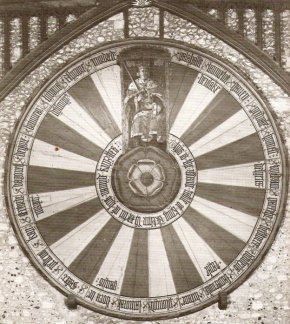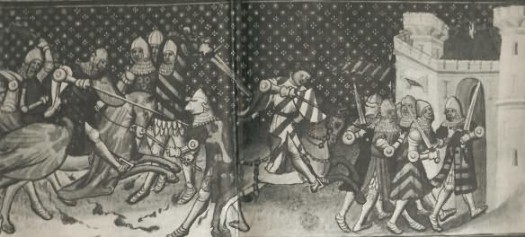
King Arthur
Knights Of The Round Table
And Associated Arthurian Characters
The Knights | The Ladies | The Characters | The Places | The Objects | Dryden's Knights | Scott's Knights
Related Texts and Sources
The Round Table in Winchester Great Hall

| Mordrede (Mordred) | Galahallt (Galahad) |
| Alynore (Alymere) | Launcelot Deulake (Lancelot) |
| Lybyus Dysconyus (Le Bel Desconneu) |
Gauen (Gawain) |
| Brumear | Percyvale (Percival) |
| Degore | Lyonell (Lionell) |
Dagonet |
Trystram Delyens (Tristan) |
Ector de Marys (Ector) |
Garethe (Gareth) |
| Kay | Bedwere (Bedevere) |
| Pelleus (Pelleas) | Blubrys (Bleoberis) |
| Safer | Lacotemale Tayle (Cotemal) |
| Bors De Ganys (Bors) | Lucane (Lucan) |
| Lamorak | Plomyde (Palomides) |
The Knights of King Arthur as listed by Chrétien de Troyes in "Erec et Enide":
- Gawain, the first
- Erec the son of Lac, the second
- Lancelot of the Lake, the third
- Gornemant of Cohort, the fourth
- The Handsome Coward, the fifth
- The Ugly Brave, the Sixth
- Meliant of Liz, the seventh
- Mauduit the Wise, the eighth
- Dodinel the Wild, the ninth
- Gandelu, the tenth
- Eslit
- Briien
- Yvain son of Urien
- Yvain of Loenel
- Yvain the Bastard
- Yvain of Cavaliot
- Garravain of Estrangot
- The Knight with the Horn
- The Youth with the Golden Ring
- Tristan
- Bliobleheris
- Brun of Piciez
- Grus the Wrathful
- The Armourer
- Karadues the Short-Armed
- Caveron of Robendic
- King Quenedic's son
- The Youth of Quintareus
- Yder of the Dolorous Mount
- Gaheriet
- Kay of Estraus
- Amauguin
- Gales the Bald
- Grain
- Gornevain
- Carahes
- Tor the son of King Ares
- Girflet the son of Do
- Taulas
- Loholt the son of King Arthur
- Sagremor the Impetuous
- Bedoiier the Marshal
- Bravain
- King Lot
- Galegantin of Wales
- Gronosis son of Kay the Seneschal
- Labigodes the Courtly
- Count Cadorcaniois
- Letron of Prepelesant
- Breon the son of Canodari
- The Count of Honolan

